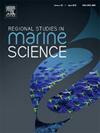黄海冷水团水产养殖区沉积物中单氧化铵酶基因的时空动态
IF 2.4
4区 环境科学与生态学
Q3 ECOLOGY
引用次数: 0
摘要
氨氧化是海洋氮循环的一个基本过程,推动氨向硝酸盐的转化,对维持深海生态系统氮平衡起着至关重要的作用。氨氧化古菌(AOA)和氨氧化细菌(AOB)是这一过程的主要贡献者;然而,它们在深海水产养殖环境中的动态仍然知之甚少。研究了黄海冷水群养殖区沉积物中古细菌和细菌amoA基因多样性、群落组成及丰度的时空变化特征。结果表明:AOB比AOA具有更多的otu、更高的多样性和丰富度。大部分AOA和AOB分别属于亚硝酸菌属和亚硝酸菌属。在12月份观察到amoA基因拷贝的最高丰度。虽然在所有采样地点和时间都检测到AOA和AOB群落的生物指标,但它们都不能被确定为水产养殖来源的指标。中性群落模型表明,AOA群落主要受随机过程的影响(R²= 88.6% %),环境因素对AOA群落的影响更大(R²= 61.3 %)。底水温和沉积物碳含量等关键环境驱动因素显著影响古菌amoA基因丰度和AOA指标丰度。这些研究结果为研究长江流域黄藻和黄藻群落的不同生态作用和聚集机制提供了新的思路。了解这些微生物动态对于评估深海水产养殖环境中氮循环的稳定性和制定YSCWM海洋水产养殖可持续管理策略至关重要。本文章由计算机程序翻译,如有差异,请以英文原文为准。
Spatiotemporal dynamics of ammonium monooxygenase (amoA) genes in sediments of the aquaculture area in the Yellow Sea Cold Water Mass
Ammonia oxidation is a fundamental process in the marine nitrogen cycle, driving the transformation of ammonia into nitrate and playing a crucial role in maintaining nitrogen balance in deep-sea ecosystems. Ammonia-oxidizing archaea (AOA) and ammonia-oxidizing bacteria (AOB) are kay contributors to this process; however, their dynamics in deep-sea aquaculture environments remain poorly understood. This study investigated the spatiotemporal variations in the diversity, community composition, and abundance of archaeal and bacterial amoA genes in sediments from Yellow Sea Cold Water Mass aquaculture area. Results revealed that AOB exhibited more OTUs as well as higher diversity and richness than AOA. Most AOA and AOB were classified into the genera Nitrosopumilus and Nitrosomonas, respectively. The highest abundance of amoA gene copies was observed in December. Although bioindicators for both AOA and AOB communities were detected across all sampling sites and times, none of them could be identified as aquaculture-derived indicators. Neutral community model indicated that AOB community assembly was primarily shaped by stochastic processes (R² = 88.6 %), whereas the AOA community was more influenced by environmental factors (R² = 61.3 %). Key environmental drivers, including bottom water temperature and sediment carbon content, significantly affected archaeal amoA gene abundance and AOA indicator abundance. These findings provide new insights into the distinct ecological roles and assembly mechanisms of AOA and AOB communities in the YSCWM. Understanding these microbial dynamics is essential for evaluating nitrogen cycling stability in deep-sea aquaculture environments and developing sustainable management strategies for marine aquaculture in the YSCWM.
求助全文
通过发布文献求助,成功后即可免费获取论文全文。
去求助
来源期刊

Regional Studies in Marine Science
Agricultural and Biological Sciences-Ecology, Evolution, Behavior and Systematics
CiteScore
3.90
自引率
4.80%
发文量
336
审稿时长
69 days
期刊介绍:
REGIONAL STUDIES IN MARINE SCIENCE will publish scientifically sound papers on regional aspects of maritime and marine resources in estuaries, coastal zones, continental shelf, the seas and oceans.
 求助内容:
求助内容: 应助结果提醒方式:
应助结果提醒方式:


